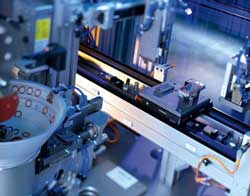
Posted to News on 20th Jun 2007, 19:34
Cutting the cost of assembling O-ring seals
Trelleborg Sealing Solutions has been working with leading manufacturers of assembly equipment to develop manufacturing and surface technologies that maximise manufacturing speeds and minimise downtime, thereby lowering overall production costs.

Trelleborg Sealing Solutions (formerly known as Busak+Shamban), a business area of Trelleborg Group, has been working in partnership with leading automated assembly equipment manufacturers such as Ohrmann Montagetechnik in Europe and AMARA in North America, for several years. The objective has been to maximise speed and quality when seals are automatically assembled into components. As manufacturers demand ever-higher velocity and yield, this has made the automatic insertion of seals even more difficult. Seal developments have focused on optimising the seal insertion process to make production quicker and more effective, maximising manufacturing speed and minimising downtime to lower overall costs.
Firstly, to ensure effective mounting of seals in automated assembly processes, seals must have sufficient elasticity and be dimensionally accurate. But successful insertion of seals is not just about them being perfectly flat and round. Other parameters must be considered when it comes to the design of the assembly machine itself, and the technology behind the seal.
Trelleborg Sealing Solutions and automated assembly equipment designers have concentrated machine and seal development on the following areas to achieve efficient seal mounting:
- Detection systems installed on machines including probes, light barriers and back-pressure controls to automatically sense if seals are present
- Closed assembly tools to avoid applying local stresses to seals during handling, which can fracture or tear seals
- Coating and surface treatment technologies to optimise friction characteristics and avoid contamination of handling and assembly equipment
- Specification of packaging, transport and storage to DIN 7716 right up to point of assembly
- Recommendation of sealing materials that have sufficient resistance to chemicals and oils, along with mechanical properties and slide behaviour suited to the assembly process
An example of the way Trelleborg Sealing Solutions has co-operated with automated assembly equipment manufacturers is in the identification of the optimum surface treatment of seals for automated assembly. Trelleborg Sealing Solutions undertook numerous test programs to solve specific issues, including one with regard to silicone coatings.
Seals are often coated with silicone to improve lubrication, which initially gives excellent sliding behaviour. However, over time the silicone dries, friction properties deteriorate and seals tend to stick during assembly.
Trelleborg Sealing Solutions performed tests that clearly demonstrated this reduction in properties. An alternative coating was established that achieved similar friction characteristics to the silicone coating when first applied. However, being a dry surface treatment, no lowering of performance was suffered over time. In addition, there was no potential contamination of the assembly system from the coating coming off the seals, which is a tendency with silicone.
Want the latest machine building news straight to your inbox? Become a MachineBuilding member for free today >>
Trelleborg Sealing Solutions (formerly Busak+Shamban)
1 Cranbrook Way
Solihull Business Park
B90 4SJ
UNITED KINGDOM
+44 (0)121 744 1221

















